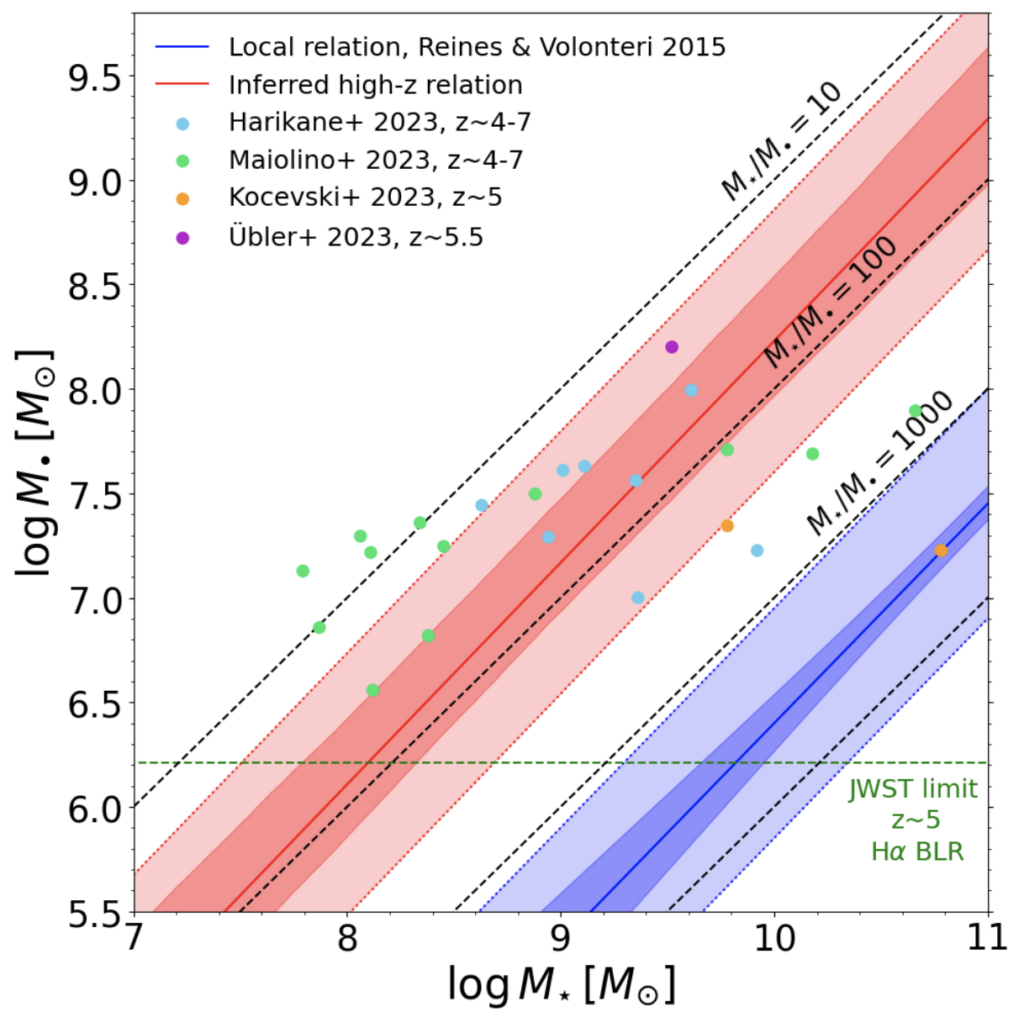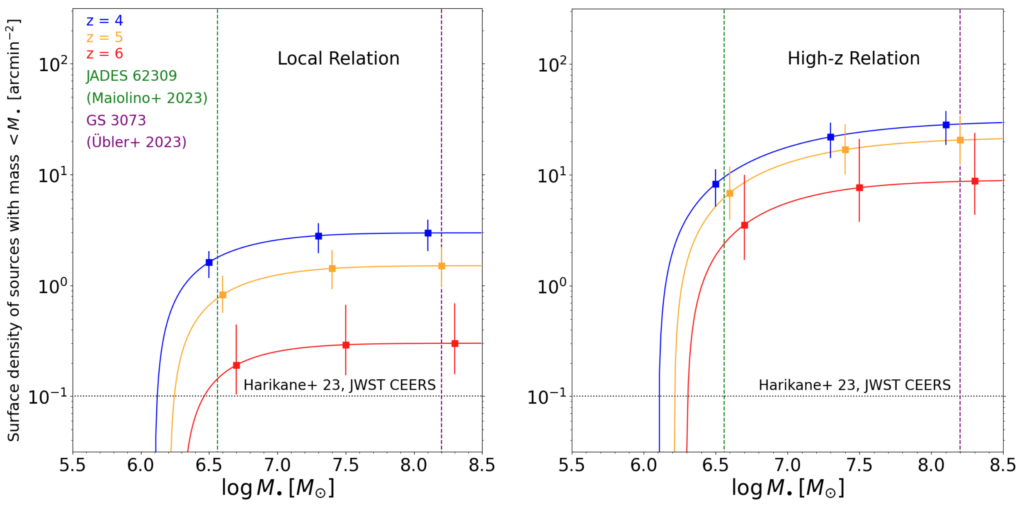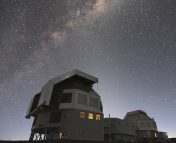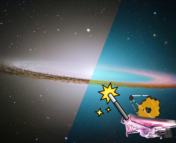Authors: Fabio Pacucci, Bao Nguyen, Stefano Carniani, Roberto Maiolino, Xiaohui Fan
First Author’s Institution: Center for Astrophysics | Harvard & Smithsonian
Status: Submitted to ApJL [open access]
Supermassive Questions
Despite the fact that supermassive black holes (SMBHs) reside at the center of nearly every galaxy, there are still questions about how these cosmic beasts are formed and how they influence their surroundings. Astronomers are still searching for conclusive evidence as to what “seeds” SMBHs – is it low-mass remnants of massive stars or heavier direct collapse black holes? Recently, a distant, “over-massive” SMBH was found with JWST and has been suggested to have a heavy seed origin, but more population-based studies and understanding of other factors that influence SMBH growth are needed to tell whether all SMBHs form from heavy seeds.
Beyond SMBH seeds, astronomers are still puzzled by an apparent interplay between SMBHs and their host galaxies, which we observe as a correlation between the SMBH mass and the host galaxy stellar mass. At first this might seem natural, but the gravitational influence of an SMBH only extends to a tiny fraction of the galaxy’s total reach. So, why do the SMBH and galaxy co-evolve to produce the tight correlations that we see? The answer seems to be related to a process called AGN feedback, in which accreting SMBHs (i.e. SMBHs that are gobbling down lots of material) launch strong outflows of gas that can inject energy into the surroundings. However, the majority of studies thus far of SMBH-galaxy co-evolution have been limited to relatively nearby systems, primarily because most of the distant, high-redshift SMBHs are accreting so rapidly that they outshine their host galaxies, making SMBH-galaxy connections nearly impossible to study. However, probing the high-redshift relationship between SMBH and host galaxy mass can provide key insights into how SMBHs are seeded and is becoming possible thanks to advancements with the newly-launched JWST!
A Supermassive Sample
In today’s paper, the authors set out to study both of these important topics related to SMBHs by compiling a sample of high-redshift SMBHs from JWST, using sources reported in three different surveys. In total, there are 23 sources in this sample, all of which have spectra taken with the NIRSpec instrument on JWST and fall within the redshift range z ~ 4-7 (which corresponds to when the universe was only 0.7-1.5 billion years old). Each source was selected based on the presence of a broad Hα line, which implies there must be an accreting SMBH and serves as a proxy for the mass of the SMBH. The extraordinary sensitivity of JWST means that it can detect dimmer SMBHs that do not outshine their host galaxies, therefore allowing for one of the first studies of the co-evolution of SMBHs and their hosts at high redshifts (z ~ 4-7).
Supermassive Implications

With the black hole masses estimated from broad Hα lines and galaxy masses estimated from modeling the spectral energy distribution of the host emission, the authors are ready to test the evolution of the SMBH-galaxy connection. Figure 1 shows the measurements for each of the 23 sources in the sample, as well as the best-fitting power law model in red. Importantly, this high-redshift relationship is statistically different from the local relation that is plotted in blue in Figure 1 at more than 3σ significance! This means that the high-redshift black holes are far more massive compared to their host galaxies compared to what we are used to in the local universe.
One important point that the authors checked was the impact of the flux-limited nature of this sample on their results. JWST can only probe Hα emission down to a specific flux, and since the SMBH mass scales with the Hα luminosity, this limits the masses of the SMBHs that can be discovered with JWST (which is shown with the green dotted horizontal line in Figure 1). The authors explored whether or not the flux-limited nature could explain the high SMBH masses, but found that even when they included a correction term for this bias in their model, the model was still significantly different from the local relation.
The implications of this high-redshift relationship between SMBH mass and galaxy mass are extremely important. One point the authors highlight in this work is that the expected number of SMBHs that JWST should see is actually much higher! This is shown in Figure 2 with the surface density of SMBHs (i.e. number per unit area on the sky) that JWST should see at different redshifts. The left panel shows the expectation when assuming the local relation between SMBH and galaxy mass, and the right panel shows the expectation when assuming the high-redshift relation. The huge increase in surface density in the right panel arises because SMBHs are 10-100 times more massive in the high-redshift relation compared to the local relation; this means that the relatively abundant small host galaxies can actually host massive SMBHs that can be seen by JWST! As to why we haven’t seen this many SMBHs with JWST already, the authors suggest that some of these sources may be accreting at a rate too low to be seen, they’re outshined by their host galaxies, or they’re too obscured by dust.

Supermassive Seeds?
The authors end today’s paper by discussing the potential connection between this work and our understanding of SMBH seeds. While this work can’t say that these SMBHs must come from heavy seeds from direct collapse black holes, the results are consistent with this picture, as is shown in Figure 3. Interestingly, the over-massive SMBHs compared to host galaxy mass is also consistent with simulations of the growth of heavy seeds, which have found that SMBHs remain over-massive until around z ~ 8 (when the universe was roughly 0.6 billion years old), where galaxy mergers can start to increase the stellar mass of the host galaxies. Ultimately, more lower mass SMBHs will help to better constrain this relationship at high redshift, and more high-redshift SMBHs discovered by JWST will help to further probe the population of black hole seeds.

Astrobite edited by Benjamin Cassese
Featured image credit: NASA GSFC/CIL/Adriana Manrique Gutierrez




